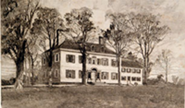
The FTSC fiscal year extends from September through August. The activities of the FTSC during a single fiscal year are described below. Please click here to view projects completed during additional fiscal years.
The FTSC at URI participating in the development of Natural Resource Condition Assessments (NRCA) for Acadia National Park (ACAD), Fire Island National Seashore (FIIS), Sagamore Hill National Historic Site (SAHI), and Gateway National Recreation Area (GATE). The goal of the Natural Reource Condition Assessment program is to determine the status of park resources, to identify knowledge gaps, and to make recommendations for futher studies that address threats to these resources. Development of NRCAs for ACAD, FIIS, SAHI, and GATE is ongoing collaborative effort involving researchers and GIS professionals from the University of Maine, Stony Brook University, the Univeristy of Rhode Island, and NPS staff from the New England Region.
Personnel from the FTSC have participated in numerous site visits and meetings, offering technical perspective on upcoming research and highlighting the need for quality data and metadata. We assessed the current status of park GIS databases and identified possible gaps in the available data.
To equip researchers at the parks, we have developed GIS databases for each park. Data for these databases were obtained from existing park databases as well as from the Inventory and Monitoring Program. Once existing data were assembled, data were mined from external databases, including the New York GIS Clearinghouse and other sources. The database structure used for ACAD was determined to be the most useful structure, and we have used it to store data for all four parks.
Many legacy datasets predate FGDC metadata standards. When possible, metadata were imported into the datasets. Datasets without metadata were given a template dataset, warning the user of possible problems and providing the user with basic information about the dataset, such as the projection and the contact for the Data Steward of the relevant park.
The FTSC at URI participating in the assessment of available data related to Submerged Resources in ten coastal parks in the Northeast Region (NER). These parks are Acadia National Park (ACAD), Assateague Island National Seashore (ASIS), Boston Harbor Island National Recreation Area (BOHA), Cape Cod National Seashore (CACO), Colonial National Historical Site (COLO), Fire Island National Seashore (FIIS), Gateway National Recreation Area (GATE), George Washington Birthplace National Historical Site (GEWA), Sagamore Hill National Historical Site (SAHI), and Saugus Iron Works National Historical Site (SAIR). The goal of the Natural Reource Condition Assessment program is to determine the status of park resources, to identify knowledge gaps, and to make recommendations for futher studies that address threats to these resources. Development of NRCAs for ACAD, FIIS, SAHI, and GATE is ongoing collaborative effort involving researchers and GIS professionals from the University of Maine, Stony Brook University, the Univeristy of Rhode Island, and NPS staff from the New England Region.
Personnel from the FTSC have participated in numerous site visits and meetings, offering technical perspective on upcoming research and highlighting the need for quality data and metadata. We assessed the current status of park GIS databases and identified possible gaps in the available data.
The Python Script Creator for Batch Processing for ArcGIS 9.2 is a prototype of what can be done with just one of the ArcGIS Geoprocessing commands using Python Scripts. The example script converts multiple image files (.tif, or .img) to multiple GRIDS. The original idea was based on the need to batch process many of the functions in ArcGIS. However, Model Builder currently lacks batch geoprocessing, and coding in Python can be a significant hurdle for some. We tested a prototype Python Script in ArcGIS 9.2 with Python 2.1 installed, and it continues to work. So feel free to pass it along. With a bit more coding, there are hundreds of others that could be added or similar pages could be developed. This script creator is also available for use with ArcGIS v9.1 (click here).
The Python Tool to Batch Convert PDF Files uses the convert function in ImageMagick to batch convert the first page of multiple PDF documents to a JPEG or PNG file. This tool is useful for creating thumbnails of multiple PDF files. This tool requires the installation of the free software package ImageMagick, available for download here (ImageMagick is not an FTSC or NPS product).

During the spring of 2006, Nigel Shaw and Mark Christiano led a group of University of Rhode Island students in the collection of GPS data at Morristown National Historical Park (MORR). The GPS Swat Team trip was conducted as part of the course, Application of GeoSpatial Tools (NRS-524), which was co-taught by Mark and Nigel. Coursework for NRS-524 included GPS theory and tutorials as well as hands on training with Trimble GPS units. Data collected at MORR included roads, culverts, wetlands, paths, picnic areas, monuments, overlooks, gravestones, trees, and other historical features specific to Saratoga. Knowledgeable NPS staff assisted with field identification of historical features. Data were post-processed, quality checked, and migrated to GIS format. All data have FGDC-compliant metadata.
The Global Positioning System Swat Team is sponsored annually by the NER GIS Program to map features in a national park. The SWAT Team collects locational and attribute data on everything from trails to rare lichens to archaeological sites and have even, on one occasion, mapped a kitchen sink location! The essence of the GPS Swat Team is that we spend a short time in the park, collect data as specified by the park staff, and provide completed digital map layers ready for use in GIS. While we prioritize for data collection projects that contribute to a specific project or base dataset, we will, in truth, map just about anything we can find in the field.